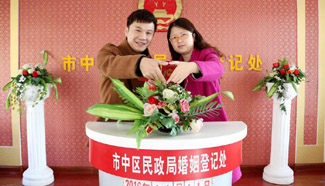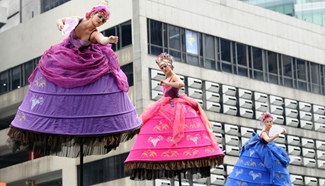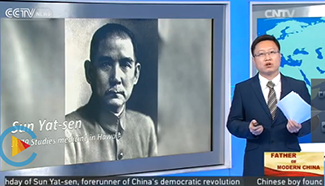BEIJING, Nov. 11 (Xinhua) -- Before age 17, Leland Sun knew little about his great-grandfather. However, he went on to spend half a century researching his prominent ancestor.
Leland, now 73, is a descendant of Sun Yat-sen, forerunner of China's democratic revolution and instrumental player in overthrowing the Qing Dynasty and ending feudalism in China.
"He was the first person to put forward the rejuvenation of China," Sun said. "He hoped China could become rich and strong like those Western countries. China is evolving into what he wants to see."
Saturday is the 150th anniversary of Sun Yat-sen's birth. In China, Sun Yat-sen is a household name. People learn about his life from history textbooks starting in childhood.
But Leland Sun, who was born in the United States, didn't know much about him.
"My grandfather, Sun Ke, didn't tell me that I am the descendant of a great man," he told Xinhua in English, as he speaks little Chinese.
When he was in military school, the teacher asked him one day to write a term paper for graduation.
"I didn't know what to write about," he recalled. "The teacher said, 'Why don't you write about your great-grandfather?'"
He went to the library and found a picture in a geography book showing Sun Yat-sen sitting behind a desk.
After he finished the 12-page paper, Leland Sun began reading everything he could find in English about his famous ancestor.
Leland worked as a stuntman before investing in real estate in the 1990s. In March 2015, he formed the Sun Yat-sen Center Foundation to help people learn more about his great-grandfather.
Sun Yat-sen has always been remembered in China.
In Wuhan, capital of central China's Hubei Province, where the Revolution of 1911 broke out, bronze statues of him were erected in the downtown area.
In Guangzhou, capital of Guangdong, where he led the first uprising, his former residence receives visitors from home and abroad.
An exhibition is being held at the residence to tell people the story behind the Sun Yat-sen suit, a traditional suit still worn by Chinese leaders.
"After the Revolution of 1911, he felt that Western-style suits didn't fit the Chinese people, while traditional robes were inconvenient, so he improved on the Western suit," said tour guide Wu Hanting.
"There are three buttons on each sleeve, symbolizing his Three Principles of the People: nationalism, democracy and people's livelihood. There is no seam at the back, symbolizing unity of the country," Wu said.
There are more than 60 parks named after Sun Yat-sen across China, with the most famous one in Beijing.
Gai Jianzhong, the director of the research office under the administration of Beijing Zhongshan Park (or the Park of Sun Yat-sen), said the park was chosen as the venue for the public memorial ceremony in 1925 due to its location.
"It is located in the urban center and near the Peking Union Medical College Hospital, where Sun's body was embalmed," Gai said.
Gai's home is not far from the park, where he spent his childhood. Still, he never imagined his career would revolve around Sun Yat-sen.
"After I started working here, I learned more and more about Sun Yat-sen," he said. "His patriotism and perseverance in spite of difficulty should be learned by the younger generation."
Like Gai, Gao Yunkun's career is also dedicated to the great man.
Gao, 43, the director of the research office of the Xiangshan Park Administration, said he has prepared an ongoing exhibition about Sun Yat-sen and his wife Soong Ching-ling.
After the public memorial ceremony in 1925, Sun's remains were moved to the Biyun Temple at Xiangshan Mountain in Beijing's northwest suburbs, less than 20 kilometers away from the city center. Some senior leaders of the Nationalist Party, or Kuomintang, such as Lien Chan and Chu Li-luan, have visited the temple.
"Preparing for the exhibition just reminds me that national self-esteem, self-respect, as well as the self-introspection Sun once called for have yet to be realized, even now," Gao said, before quoting Sun: "The revolution has not yet succeeded. Comrades must carry on!"
The exhibition, which opened in May, has attracted about 150,000 visitors. Mu Rongjun, a professor with the Harbin Institute of Technology, is one of them.
"He founded the Republic of China, laying the foundation for today's China," he said. "He should be remembered by all Chinese people."
Leland Sun said his children are helping with his foundation and learning Chinese. He himself is writing a book, which he plans to finish next year.
"It is about what he did overseas," he said. "His efforts should be remembered."










